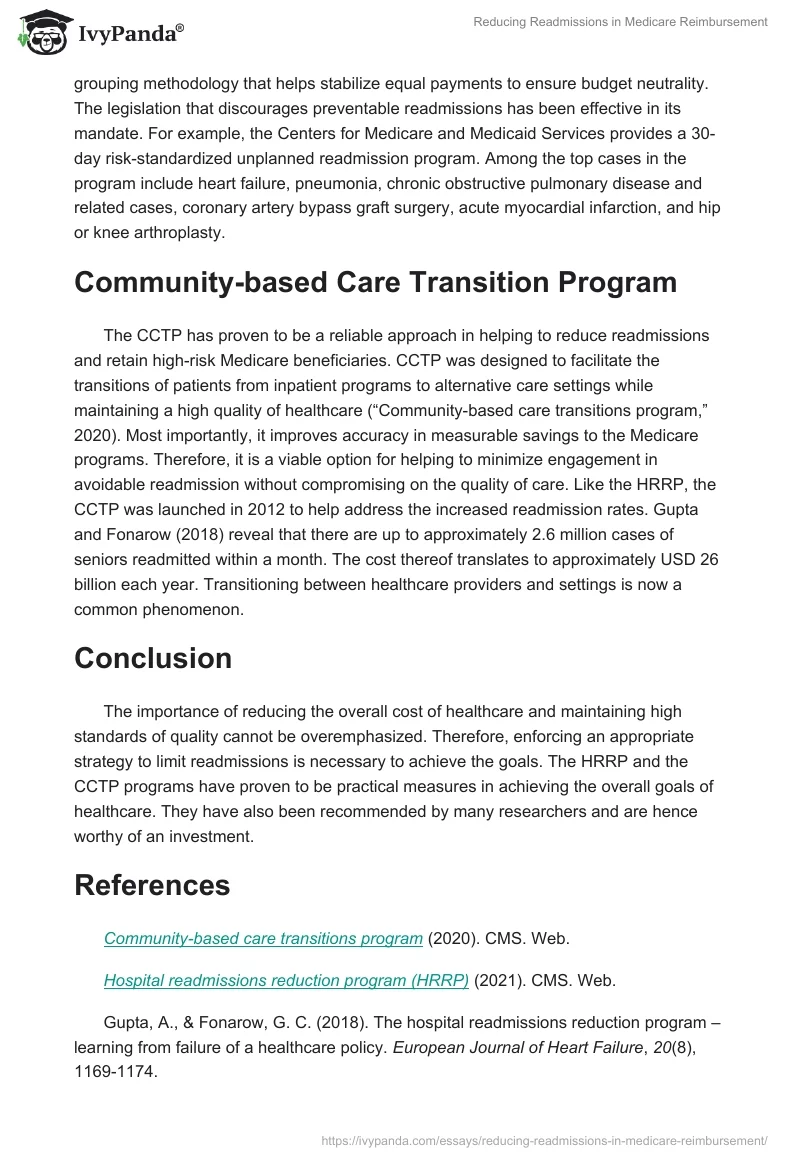Introduction
Preventing readmissions in hospitals go a long way in saving billions of taxpayers’ dollars annually. Consistent reforms in the healthcare sector have led to increased pressure not only on cost reduction but also on reducing preventable re-hospitalizations. With some cases, such as urgent and surgical circumstances requiring inpatient care, others could be avoided to help enhance the quality of healthcare in the long run. Some important strategies necessary to help reduce these admissions include the Hospital Readmissions Reduction Program (HRRP) and the Community-based Care Transition Program.
Hospital Readmissions Reduction Program
This value-based purchasing program aims at reducing preventable readmissions. The approach is aligned with the government policy designed to improve healthcare for all through payment for quality care (“Hospital readmissions reduction program,” 2021). It helps encourage healthcare institutions to invest in communication channels that will improve coordination between patients and caregivers. Most importantly, it is applicable and has proven practical in the majority of hospitals seeking to improve their quality of services.
The Federal government has been keen on employing tactics designed to reduce healthcare costs while maintaining the high quality of services. For example, the secretary of the U.S. Department of Health and Human Services is committed to reducing funds for institutions with excess rates of readmissions (Warchol et al. 2019). Since the enacting of Section 1886 of the Social Security Act in October 2012, the requirement has helped encourage hospitals to minimize preventable readmissions. This act directs the Centers for Medicare and Medicaid Services to evaluate the performance of healthcare institutions in comparison to others with a relative proportion of patients who are eligible for full Medicare benefits. This approach is the peer grouping methodology that helps stabilize equal payments to ensure budget neutrality. The legislation that discourages preventable readmissions has been effective in its mandate. For example, the Centers for Medicare and Medicaid Services provides a 30-day risk-standardized unplanned readmission program. Among the top cases in the program include heart failure, pneumonia, chronic obstructive pulmonary disease and related cases, coronary artery bypass graft surgery, acute myocardial infarction, and hip or knee arthroplasty.
Community-based Care Transition Program
The CCTP has proven to be a reliable approach in helping to reduce readmissions and retain high-risk Medicare beneficiaries. CCTP was designed to facilitate the transitions of patients from inpatient programs to alternative care settings while maintaining a high quality of healthcare (“Community-based care transitions program,” 2020). Most importantly, it improves accuracy in measurable savings to the Medicare programs. Therefore, it is a viable option for helping to minimize engagement in avoidable readmission without compromising on the quality of care. Like the HRRP, the CCTP was launched in 2012 to help address the increased readmission rates. Gupta and Fonarow (2018) reveal that there are up to approximately 2.6 million cases of seniors readmitted within a month. The cost thereof translates to approximately USD 26 billion each year. Transitioning between healthcare providers and settings is now a common phenomenon.
Conclusion
The importance of reducing the overall cost of healthcare and maintaining high standards of quality cannot be overemphasized. Therefore, enforcing an appropriate strategy to limit readmissions is necessary to achieve the goals. The HRRP and the CCTP programs have proven to be practical measures in achieving the overall goals of healthcare. They have also been recommended by many researchers and are hence worthy of an investment.
References
Community-based care transitions program (2020). CMS. Web.
Hospital readmissions reduction program (HRRP) (2021). CMS. Web.
Gupta, A., & Fonarow, G. C. (2018). The hospital readmissions reduction program – learning from failure of a healthcare policy. European Journal of Heart Failure, 20(8), 1169-1174.
Warchol, S. J., Monestime, J. P., Mayer, R. W., & Chien, W. W. (2019). Strategies to reduce hospital readmission rates in a non-Medicaid-expansion state. Perspectives In Health Information Management, 16.


